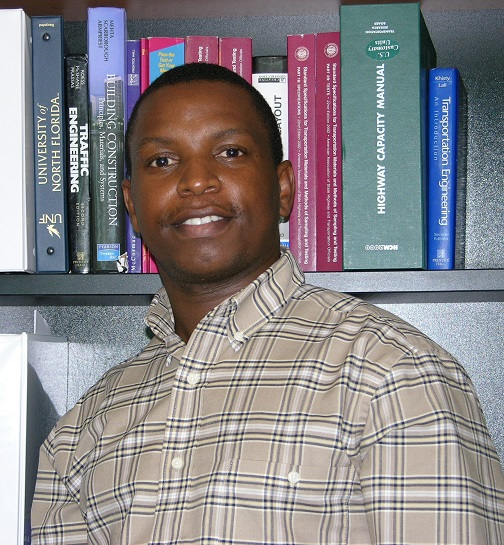
Thobias Sando, Ph.D., P.E., PTOE
Dr. Thobias Sando is a Professor at the University of North Florida (UNF) School of Engineering. He received his Ph.D. in Civil Engineering with a focus on Transportation Engineering from the Florida State University in 2005. He teaches and conducts research in the area of transportation engineering. His research interests include modeling of highway safety data, intermodal facility design, intelligent transportation systems, operational analysis of bicycle and pedestrian facilities, and traffic simulation. He currently directs the Transportation Research Laboratory at UNF. Throughout his ten-year tenure at UNF, Dr. Sando has secured about two million dollars in research grants. Since joining UNF, his research program has supported a total of 20 students with stipend and tuition support – 10 graduate and 10 undergraduate students. More importantly, his efforts helped UNF become a part of the Center for Accessibility and Safety for an Aging Population (ASAP), a University Transportation Center (UTC) program; this is a prestigious transportation research funding initiative by the US Department of Transportation (USDOT). ASAP is a consortium of three universities led by Florida State University, in partnership with Florida A&M University (FAMU), and UNF. Dr. Sando’s research group at UNF is student-centered, and has currently grown to include nine members – two principal investigators, one research associate, six graduate students and one undergraduate student. He also helps supervise several Masters’ and Ph.D. students at FSU as part of ASAP activities.
Dr. Sando has been involved in several ASAP projects as a Principal Investigator (PI) or Co-PI. He considers a research project a success if its findings are published in a reputable journal or presented at a conference. For example, the findings of his project titled “Analyzing Crash Clusters near Senior Destination Sited Using GIS” produced a paper titled "GIS-based Spatial and Temporal Analysis of Aging-Involved Accidents: A Case Study of Three Counties in Florida," which was published in the Journal of Applied Spatial Analysis and Policy. The results from the Phase II of this project was presented at the 2018 Transportation Research Board (TRB) Meeting, in an article titled “Influence of Intersection Characteristics on Elderly Driver Crash Involvement.”
In addition, Dr. Sando co-authored an article titled "Metadata-based Needs Assessment for Emergency Transportation Operations with a Focus on an Aging Population: A Case Study in Florida" in Transport Reviews, based on the work on the ASAP project titled “Needs Assessment for Multi-Modal Emergency Transportation Operations with a Focus on an Aging Population.” Ms. Angela Kitali, a former Master’s degree student at UNF, wrote her thesis based on another ASAP project titled “An Investigation of Pedestrian Signals to Reduce Intersection Crashes and Red Light Violations for Elderly Drivers.” Two papers were published from that thesis – one in the Journal of Accident Analysis & Prevention with a title “A Full Bayesian Approach to Appraise the Safety Effects of Pedestrian Countdown Signals to Drivers,” and another in the ASCE Journal of Transportation Engineering (“Appraisal of Safety Effects of Pedestrian Countdown Signals to Drivers Using Crash Modification Factors”).
Apart from these ASAP projects, Dr. Sando initiated a system to challenge students from all the three member institutions (FSU, FAMU and UNF), to come up with research ideas related to ASAP that have publication potentials. This system has brought tremendous success. For example, at UNF, two students wrote their theses based on the student-centeredprojects. The first thesis produced one TRB journal publication titled “Age-Based Simulation of Merging Behavior at Freeway Merging Ramps” and one TRB presentation titled “Older Drivers’ Behavior at On-Ramp Merging Areas.” Similarly, the second thesis resulted in two TRB papers – one titled “Safety Evaluation of the Advanced Stop Assist System in Connected Vehicle Environment” that has been accepted for publication, and another paper titled “Enhancing The Green Light Optimized Speed Advisory System to Incorporate Queue Formation,” which was accepted for presentation. Out of student-centered projects at UNF, two more ASAP-related papers have been published: (1) Understanding the Factors Associated with Severity of Aging Population-involved Pedestrian Crashes in Florida in Advanced in Transportation Studies; and (2) Evaluating Pedestrian Crash Severity Using Bayesian Complementary Log-log Model for Improved Prediction Accuracy in the Transportation Research Record.
Under Dr. Sando’s leadership, UNF has become a leader in microscopic traffic simulation efforts for ASAP. Over the last three years, the UNF Transportation Research Laboratory team has amassed significant advanced knowledge on microscopic traffic modeling. UNF graduate students have twice prepared and facilitated training at the FAMU-FSU College of Engineering on the use of microscopic traffic simulation tools. There are several significant contributions underway related to the study of aging drivers and microscopic traffic modeling of connected and autonomous vehicles.
Dr. Sando aspires to have a long-lasting research relationship with the FAMU-FSU College of Engineering. He has started laying the groundwork to establish a joint Ph.D. degree program between FSU and UNF. In the meantime, he continues to provide mentorship and leadership to more than half-a-dozen students who are working on various ASAP projects, both at UNF and FSU. He enjoys collaborating with FAMU and FSU faculty in making the ASAP a success.
Return to the Newsletter